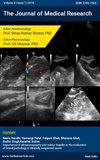Correlates of Traditional Chinese Medicine Syndrome Types in Polycystic Ovary Syndrome
引用次数: 0
Abstract
[Objective] Polycystic ovary syndrome (PCOS), a common female health condition caused by a hormonal imbalance due to the ovaries producing excess male hormones, is also considered a chronic endocrine-metabolic syndrome. According to the traditional Chinese medicine (TCM) theory, multiple factors including insufficiency of kidney and liver as well as phlegm dampness may result in PCOS. This study aimed to investigate the distribution pattern of TCM syndrome types in patients with PCOS, and to determine the glucose metabolism status among these patients. [Methods] A total of 60 patients diagnosed with PCOS in our center were enrolled in this study. These patients were classified into three groups based on their TCM syndrome types, including phlegm dampness syndrome, liver stagnation syndrome, and kidney insufficiency syndrome. A uniformly formulated basic information sheet was collected, and all of them underwent glucose tolerance test (OGTT). The correlations of body mass index (BMI), waist to hip ratio (WHR), and glucose metabolism in patients with different syndromes were compared. [Results] The patients with phlegm dampness syndrome type (n=32) were the most among these 60 patients with PCOS, accounting for 53.33%, followed by liver stagnation syndrome (n=18; 30%) and kidney insufficiency syndrome (n=10; 16.67%). The BMI and WHR of patients with phlegm dampness syndrome were higher than those with liver stagnation syndrome and kidney insufficiency syndrome (P<0.01). There was no significant difference in the incidence of abnormal glucose metabolism (IFG/IGT/diabetes) among the three groups (P>0.05). [Conclusions] The main TCM syndrome type in patients with PCOS is phlegm dampness syndrome, which was linked to obesity and abdominal obesity.多囊卵巢综合征中医证型的相关性研究
【目的】多囊卵巢综合征(PCOS)被认为是一种慢性内分泌代谢综合征,是由于卵巢分泌过多的雄性激素而导致的激素失衡,是一种常见的女性健康状况。根据中医理论,多囊卵巢综合征可能由肝肾功能不全、痰湿等多种因素引起。本研究旨在探讨PCOS患者中医证型的分布规律,了解PCOS患者的糖代谢状况。【方法】本研究共纳入60例经诊断为PCOS的患者。根据中医证型将患者分为痰湿证、肝郁证、肾虚证3组。收集统一制定的基本信息表,并进行葡萄糖耐量试验(OGTT)。比较不同综合征患者的身体质量指数(BMI)、腰臀比(WHR)和糖代谢的相关性。[结果]60例PCOS患者中痰湿证型最多(n=32),占53.33%,其次为肝郁证(n=18);30%)和肾功能不全综合征(n=10;16.67%)。痰湿证的BMI和WHR高于肝郁证和肾虚证(P0.05)。【结论】PCOS患者中医证型以痰湿证为主,与肥胖、腹型肥胖相关。
本文章由计算机程序翻译,如有差异,请以英文原文为准。
求助全文
约1分钟内获得全文
求助全文

 求助内容:
求助内容: 应助结果提醒方式:
应助结果提醒方式:


